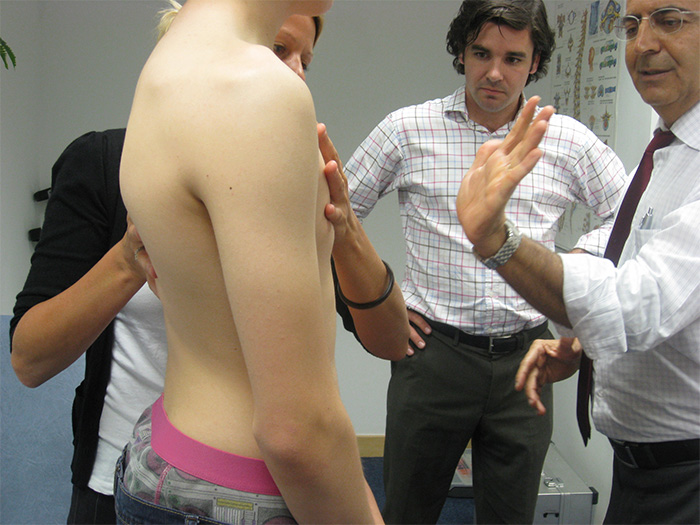Chest deformities like pectus excavatum and pectus carinatum are quite common in teenagers. Particularly in an age of social media and body shaming, the physical appearance of both conditions can be very challenging for some adolescents.
LOC clinicians are very much aware of this as we have discussed the psychological impact with parents and directly with patients. Patients are unwilling to take their t-shirts off, go swimming or put themselves in any position where they might reveal their chests.
Not surprisingly both parents and teenagers are looking for an answer. Surgery on the NHS used to be an option but even before the pandemic that option had become increasingly unavailable since the condition was deemed to be largely cosmetic and no risk to physical health.
LOC has been offering a non-surgical solution to the problem since 2010. Our treatment combines bespoke chest braces with a very specific set of exercises.

Pectus Excavatum, also known as 'funnel' or 'sunken' chest, is where the breast bone is pushed abnormally inward.
It is the most common form of congenital chest deformity which tends to become exaggerated during puberty where growth spurts cause the cartilage and bones to grow at a rapid rate.
For patients considering our non-surgical treatment for pectus excavatum, we offer the opportunity for an initial free consultation via Skype, Facetime or Zoom.

Pectus carinatum, also known as 'pigeon chest' is a congenital deformity of the anterior chest wall, and occurs when the breast bone (or sternum) is pushed outward by an abnormal overgrowth of cartilage.
Orthotic bracing is proven to be a safe and effective way to provide successful outcomes without surgical intervention.
For patients considering our non-surgical treatment for pectus carinatum, we offer a free online consultation with one of our pectus specialists.

LOC's pectus treatment is non-surgical and involves wearing a bespoke brace or orthosis called a 'Dynamic Chest Compressor', combined with a programme of Yoga exercises that have been developed specifically to augment our non-surgical treatment.
Most NHS trusts no longer recommend surgery for pectus carinatum and pectus carinatum as the conditions are considered to be cosmetic and no threat to physical health.
Our experience and development of custom-made braces has led to many patient success stories.

The Dynamic Chest Compressor is a chest brace used to non-surgically treat pectus carinatum and rib flaring. Also referred to as a pectus brace, it applies pressure over areas of the skeleton to remodel the chest and ribs.
Each pectus brace we make is entirely bespoke to each patient's specific chest shape and is designed to be worn throughout treatment.

Vacuum Bell Therapy is a non-surgical treatment option for pectus excavatum, a pectus deformity that causes the chest to appear sunken or caved in.
The manual pump sucks the air out of the device, creating a vacuum that pulls the depressed sternum and ribs outward. Over time, this pressure gently reshapes the chest and guides the sternum back to its normal position.

Rib flaring is where the ribs of the chest protrude outward, causing a noticeable bulge on the sides of the chest. The condition is common in pectus excavatum patients and can exacerbate chest deformity. Flared ribs can be treated with a bespoke rib flaring brace which moves the ribs back into a corrective position over time.

We offer free online pectus excavatum and pectus carinatum consultations via Skype, Facetime or Zoom for those worried about their chest shape.
Our treatment programme will be explained in detail so you can see whether treatment is right for you.

The London Orthotic Consultancy has been providing non-surgical pectus treatment since 2010 achieving positive results in our patients.
We are proud to be the pioneers of this treatment in the UK and are happy to share some patient successes for those who have undergone Pectus Carinatum treatment with us.

The London Orthotic Consultancy has been providing non-surgical pectus treatment since 2010 achieving positive results in our patients.
We are proud to be the pioneers of this treatment in the UK and are happy to share some patient successes for those who have undergone Pectus Excavatum treatment with us.

LOC director and pectus specialist, Sam Walmsley, has recorded a series of videos answering our client's frequently asked questions about our pectus treatments and exercise programmes.
For patients who want to avoid surgery, non-surgical pectus treatment can be a great way to achieve a flatter chest, but often, patients are unsure of what treatment involves.

We offer orthotic treatment for international patients seeking non-surgical pectus excavatum and pectus carinatum bracing in the UK. Our specialist clinicians have extensive experience treating pectus deformity patients from around the world.
We regularly treat international patients with our evidence-based orthotics including those from Europe, South America and the Middle East.

Information and price lists for our comprehensive pectus excavatum and pectus carinatum treatment packages, which include personal support throughout treatment, a bespoke exercise regime and physiotherapy support.
All fees associated with your treatment are included, such as appointments required for the duration of treatment.
There is no unified opinion on causation, but there is evidence to suggest that both pectus excavatum and pectus carinatum can be inherited conditions.
We are indebted to the late Dr Haje for the information that follows. Dr Haje was widely regarded as the world's leading authority on the non-surgical treatment of pectus deformities.
We have summarised his audit of the 4,346 patients he treated in the following page.

Above: Dr Haje training LOC staff in 2010
The London Orthotic Consultancy's pectus treatment is non-surgical and involves wearing a bespoke brace or orthosis called a 'Dynamic Chest Compressor', combined with a programme of daily exercises. LOC has pioneered this method of treatment in the UK.
Although the optimum age for non-surgical treatment is during puberty, the key determining factor is the pliability of the chest wall so older patients can also benefit if there is a ‘give’ in their chest wall.
For further information about our non-surgical treatment programme and the use of orthoses, read about our non-surgical pectus treatment.

Most NHS trusts no longer recommend surgery for pectus carinatum and pectus carinatum as the conditions are considered to be cosmetic and no threat to physical health. Privately the type of surgery performed in the UK is either the Nuss or Ravitch procedures. The Nuss procedure is minimally invasive compared to the Ravitch.
Good results have been reported from both types of surgery and patients are generally pleased with the improvement in chest shape. However, these procedures do not address the problem of rib flaring, which is fairly common, and patients can be left with visible surgical scarring.
Read more about treatment for pectus deformities.


Join The London Orthotic Consultancy in celebrating Cerebral Palsy Awareness Day on March 25th. Learn just how important expert orthotic care is in enhancing mobility, independence, and quality of life for children and adults with cerebral palsy.

Introducing the Agilik™ smart orthosis, a cutting-edge, powered knee orthotic now available in the UK through the London Orthotic Consultancy. Unlike traditional KAFOs or heavy exoskeletons, the Agilik™ provides dynamic knee assistance and offers real-time support, reducing fatigue and improving posture. This pioneering, modern technology can help children and adults with lower limb weakness walk more efficiently and naturally. We are honoured to be selected as the exclusive paediatric specialist centre in the UK for the Agilik™ device.

When Sophie noticed her baby Max had a persistent flat spot on his head, she was told it would resolve naturally—but it didn’t. Seeking a second opinion led her to the London Orthotic Consultancy, where Max was diagnosed with severe plagiocephaly.

A little more than four years after the LOCband Lite's launch, we're proud to have successfully treated our 250th helmet therapy patient at our Romford clinic using our cutting-edge 3D-printed cranial band. After five months of treatment, her final scan showed that her asymmetry had decreased from 12 mm to 3 mm.

Sky News published an article this month quoting scientists at Southmead Hospital who claimed there was a lack of research into flat head syndrome and its treatment with cranial remoulding (helmet) therapy. This is our response.

With our non-surgical treatment plan, Alex achieved 100% chest correction in just two years. His treatment involved a combination of dynamic chest compressor and vacuum bell therapy treatment to address his pectus excavatum and rib flaring.

Learn how a custom carbon fibre AFO helped Gill regain mobility and comfort despite complex challenges from shin bone (tibia) removal. We created a truly tailored orthotic solution made from pre-preg carbon fibre at our Cambridge clinic.

Discover how bespoke orthotics and the OSKAR program with Elaine Owen transformed Archie’s life with cerebral palsy quadriplegia, helping him avoid a wheelchair and achieve greater mobility.